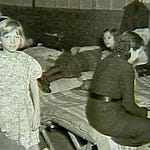December 16 marked the anniversary of the 1967 collapse of the bridge that crossed the Ohio River between Point Pleasant, West Virginia, and Gallipolis, Ohio. The Point Pleasant Bridge is usually called the Silver Bridge, and its collapse is often associated with the Mothman, a creature reportedly sighted in the area leading up to the disaster.
The devastating event took place at rush hour, on a bridge built in 1928 when Model Ts were in use, not the heavier cars that followed. Two cars avoided plunging into the river, but 46 people died, and 9 bodies were never recovered.
My great-grandmother lived on the Ohio side of the bridge and we crossed it several times visiting family before its collapse—yes, I’m “that” old. This month, we’ll explore bridge construction techniques, the disaster itself, the folklore and history of the Mothman, and a good bit more within ten questions.
Note to my fantastic new subscribers:
Monthly trivia is for sport. It’s not a test of intelligence or character. I couldn’t answer these questions without a significant amount of research, either! Do your best and enjoy learning something new. Answers in the footnotes.
QUESTIONS
The Silver Bridge was named for:1
Beloved local architect John H. Silver, who was born in Point Pleasant, but died one month before the bridge opened in 1928.
It was the first bridge in the United States to use eyebar chain suspension, a design that relied on a series of metal links (eyebars) to support the structure. Its shiny aluminum paint was innovative for the time, so the locals disregarded its official name.
Both.
We often tell our children that the weakest link in a chain determines its fate. This is also true of the Silver bridge collapse because…2
A tiny crack developed in the lower part of eyebar 330 due to stress corrosion cracking. When the crack grew, it caused a sudden brittle fracture of the eyebar, leading to the rapid failure of the suspension chain and the subsequent collapse of the entire bridge.
In 1968, a junior-level bridge inspector noticed the stress on eyebar 330 and reported it to his supervisor. Instead of placing the issue on a list of items to re-inspect, the boss hid the report. Only after the bridge collapsed did the junior inspector come forward, but since he didn’t keep his own copy of the report, and the official copy of the file had been “temporarily misplaced,” the federal inspectors with the National Transportation Safety Board (NTSB) wrote him off as a glory seeker until he was vindicated in 1997 when the file was found.
Both.
The eyebar chain system was considered innovative because it used fewer materials compared to traditional suspension cables. Which of the following is true about bridge design? More than one may apply.3
The eyebar design's failure mode is non-redundant, meaning that if one key component fails, the entire structure can collapse.
Today, bridges typically use cable-stayed or suspension systems with wire cables, which are more robust and offer multiple lines of support.
Most existing bridges with similar designs to the Silver Bridge have either been retrofitted or replaced to meet modern safety standards.
A cryptid is an animal or creature that is said to exist but has never been proven to do so. Cryptids are often featured in folklore and other accounts, and the list includes Mothman. What other creatures are considered to be cryptids? More than one may apply.4
Bigfoot/Sasquatch
The Loch Ness Monster
The Jackalope
The Flatwoods Monster aka “Braxie”
For a year prior to the collapse of the Silver Bridge, the Mothman was sighted in the area, leading to the hypothesis that Mothman either caused or prophesied the accident. Which of the following characteristics were described by people who claimed to see the Mothman? More than one may apply.5
Height between 6 to 7 feet with a humanoid form.
Wingspan 10 to 15 feet, resembling those of a bat or bird.
Large, glowing red eyes said to shine or glow in the dark.
The creature’s head seemed small or nonexistent, with the eyes appearing to be set directly into its shoulders or chest area.
What do skeptics of Mothman believe the sightings misidentified? More than one may apply.6
Barn owls, barred owls and snowy owls.
Herons, or sandhill cranes.
An extra-dimensional spirit monster heralding the Age of Aquarius.
Richard Gere and Laura Linney starred in a 2002 movie about the Silver Bridge collapse. The Mothman Prophesies is a supernatural thriller about a journalist (Gere) whose wife sees the Mothman before she dies in a car accident. Two years later, he finds himself in Point Pleasant. Were any TV shows/episodes based on the Mothman? If so, name the show(s).7
The 2002 movie kicked up interest in the Silver Bridge collapse and all things Mothman. Unveiled a year later, in 2003, Point Pleasant West Virginia, has its own Mothman statue made of stainless steel. How did artist Bob Roach land on the final design? 8
Interviewing witnesses.
Frank Frazetta's 1980 painting (as featured on the cover art for a paperback edition of John A. Keel's book, The Mothman Prophecies, which was used by screenwriters of the movie of that name).
He modified the original Mothman statue in Fryburg, Germany, where miners saw a headless winged creature with red eyes at the entrance of a mine in 1978. They evacuated immediately. The creature became known as the "Freiburg Shrieker," and had the physique of a body builder with wings.
What can visitors see at the Mothman Museum in Point Pleasant, West Virginia?9
Eyewitness accounts and newspaper clippings about the original Mothman sightings.
Props and costumes from the 2002 film The Mothman Prophecies.
Artifacts and exhibits related to the Silver Bridge collapse of 1967.
A taxidermic Sandhill crane made to look like Mothman.
True or false? In June 2020, a petition on Change.org was initiated to replace Confederate statues in the United States with statues of Mothman. By July 2020, the petition had garnered over 22,000 signatures.10
Intermission
There’s a good podcast about the collapse of the Silver Bridge and Mothman here at Ohio Mysteries. Click through for newspaper clips and such, but you’ll have to ignore the incorrect pronunciation of Gallipolis. Trust me on this—I say it like the locals.
A quick search revealed other podcasts, so please let me know if any are worthwhile.
ANSWERS
The only answer is b). The architect of the Point Pleasant Bridge is unknown since the design was overseen by engineers at J.E. Greiner Company, a prominent Baltimore firm specializing in bridge design during that era.
The only answer is a). The location of the crack was inaccessible for visual inspection without disassembling the eyebar joint, making detection nearly impossible. I made up option b). and your clue to that might have been the 1968 date. That said, b). is the kind of story we’ve heard hundreds of times in similar stories, huh? The collapse prompted one of the first major bridge failure investigations by the NTSB. The disaster resulted in the creation of national bridge inspection standards in 1968 to prevent similar failures.
C’mon, I don’t have unreasonable expectations for your bridge knowledge! All three are true. Two bridges in the Ohio River region with the eyebar chain system were demolished in the wake of the Silver Bridge collapse: Hi Carpenter Bridge (St. Marys Bridge) in St. Marys, West Virginia, and Hercules Bridge in Zanesville, Ohio.
All are “true” per the dozen or so witnesses. Mothman shares characteristics with other cryptids, like owls or large birds, but its humanoid appearance and glowing eyes set it apart.
Most experts say the Mothman was a misidentified large bird with reflective eyes that could appear otherworldly in the dark. While all owls have “eyeshine” barred owls have stronger eyeshine than barn owls, and the amount of blood vessels around the eye makes it especially dramatic in the barred owl. Snowy owls are not nocturnal, but are crepuscular, meaning they are most active at dawn and dusk. This makes answer a) incorrect because it includes barn and snowy owls in the same answer with barred.
What about the crane and heron? Sandhill cranes are not typically found in the area where the Mothman was sighted, but their physical characteristics are similar to the description of the Mothman, so I’ll allow for the possibility that one was off the normal migratory route when sighted. If eyeshine was not noted in the sightings, it's more likely that witnesses saw a Great Blue Heron. Herons hunch their necks, which sandhill cranes do not, which might explain the belief that Mothman’s eyes came from his chest or shoulders. Answer b) is most correct, but let’s not discount that Age of Aquarius connection! Scoring here on the 981 Project is on the honor system, so I leave you to your own conscience.
In an article published on Audubon’s website, both the Mothman and the Flatwoods Monster/Braxie, are probably owls. According to Joe Nickell, an author and investigator with the Committee for Skeptical Inquiry said, “I think to do this, you have to take people at their word. You take people’s description—allowing for some error—and match it to a real animal in the real world.”
In that same article, Nickells explains how witnesses could mistake a 17- to 20-inch owl with a 6-7 foot humanoid. In a 2010 episode of the television show MonsterQuest, Nickells drove volunteers down a dark road lined with plywood Mothmen, complete with bike reflectors for eyes. None of the volunteers were able to correctly guess the size of the cutouts. “It’s very hard to judge the size of something seen at night at an unknown distance, and if you misjudge how far away it is, you misjudge its height by the same proportion,” Nickells says. “Frightened people also tend to fixate on the object of their fear, causing it to loom larger in their memory. Taken together, it’s easy to see how an unexpected encounter with a Barred Owl could be a memorable—and potentially terrifying—experience.”
You betcha!
MonsterQuest (History Channel). Episode: "Mothman” investigated eyewitness accounts and theories about the Mothman, blending interviews, reenactments, and cryptozoological exploration.
The X-Files (Fox): While not directly featuring Mothman, the series often draws on cryptid lore. The episode "Detour" (Season 5) includes humanoid creatures with glowing eyes, inspired in part by cryptids like Mothman.
Ancient Aliens (History Channel). Episode "Creatures of the Deep" Explores Mothman as a possible alien or interdimensional being tied to UFO sightings.
Mysteries at the Museum (Travel Channel): Features a segment on Mothman, focusing on its connection to the Silver Bridge collapse and its role in Point Pleasant folklore.
Only a) and b) are true. That said, there was a sighting of a Mothman-like creature in Fryburg, Germany in 1978. They didn’t erect a statue there, though.
Only a), b), and c) are correct. If someone can get the museum to gussy up a stuffed Sandhill crane like Mothman, I deserve credit for the idea.
Absolutely true. The petition, titled "Change every Confederate Statue to a Mothman Statue," was started on June 10, 2020, and addressed to various state senates and governors. It called for the removal of Confederate statues, describing them as "harmful" and "racist," and proposed replacing them with statues of celebrated American figures, primarily Mothman. The petition emphasized that Mothman, unlike Confederate figures, does not embody racist or oppressive legacies and is a cultural icon significant to West Virginia and American folklore.














